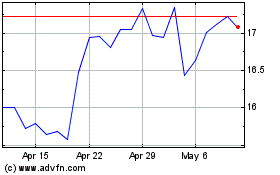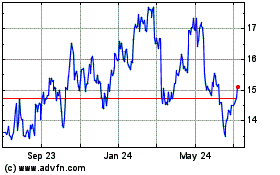S&P Cuts Rio de Janeiro State's Credit Rating
August 25 2016 - 6:00PM
Dow Jones News
RIO DE JANEIRO—Days after the close of the 2016 Olympics, the
state government of Rio de Janeiro had its credit rating slashed
three notches by Standard & Poor's, in the latest development
in a fiscal crisis that shows no sign of letting up.
Rio state—responsible for key services, such as policing and
sewage, as well as an unmet commitment to clean up heavily polluted
waterways in time for the Games—faces a "heightened risk of
default," S&P said Wednesday night in a press release. The
ratings firm cut Rio's debt to CCC- from B-, indicating that "a
default, distressed exchange or redemption appears to be
inevitable" barring "significantly favorable" changes in the
state's circumstances.
Rio's fiscal problems trace to the commodity boom, when high oil
prices and an ambitious expansion plan by national oil company
Petró leo Brasileiro SA seemingly promised to fill the state's
coffers with royalties. So the state went on a hiring spree, more
than doubling its payroll between 2009 and 2015, and took on major
spending commitments, such as a $3 billion subway line for the 2016
Olympics.
Then oil prices fell, and Brazil's worst recession in
generations clobbered Rio's tax revenues. Rigid spending
requirements on health and education, combined with laws that make
it nearly impossible to lay off public-sector employees, caused the
state government's deficit to balloon.
The federal government temporarily plugged Rio's budget hole
with a 2.9 billion reais ($899 million) cash injection after the
state governor declared a fiscal "calamity" in June, warning of
draconian cuts to public services. But it is unclear how long that
will last.
S&P said Rio's operating deficit will likely reach 8.4
billion reais this year, equal to about 17% of expenses, and will
maintain similar deficits in the next 12 to 18 months.
Rio's Finance Secretariat said Thursday in an emailed statement
that the state "is concentrating its efforts in pursuit of
balancing its finances, but the recovery of Rio's economy depends
also on the Brazilian economy."
Most states' debt in Brazil is guaranteed by the federal
government, which paid 535 million Brazilian reais to creditors on
Rio's behalf between May and July after it missed payments. But
with an estimated 2.5 billion reais in debt service coming due in
the next six months, Rio's ability to meet its obligations "is
doubtful" without help, S&P said.
"The ratings on Rio reflect a deep financial stress…a
deteriorating cash position, and greater uncertainty over the
state's capacity and willingness to make full and timely payments
on its financial obligations," S&P said. "However, we believe
that the institutional framework in Brazil, though confronting
increasing risks, continues to provide support."
Brazil's first Olympic Games, which ended Sunday, were regarded
as an operational success despite minor problems, such as long
lines at venues, transport headaches and a diving pool that
mysteriously turned green. Sporting victories, including Brazilian
gold medals in men's soccer and volleyball toward the end of the
Games, helped the host country finish on an upbeat note.
But critics have said the money used to host the Olympics could
have been better spent.
Although officials say the Games' total cost was about $13
billion, the true cost—including lost productivity, land grants to
the private sector and other factors—likely is closer to $20
billion, said Andrew Zimbalist, an economics professor at Smith
College and author of "Circus Maximus: The Economic Gamble Behind
Hosting the Olympics and the World Cup."
Beyond the economic costs, Mr. Zimbalist said, the Games exposed
governmental inefficiency and corruption, Rio's pervasive urban
violence and other problems, tarnishing the city's image.
"If the Rio brand has improved, I'm flabbergasted," he said.
Reed Johnson contributed to this article.
Write to Paul Kiernan at paul.kiernan@wsj.com and Rogerio
Jelmayer at rogerio.jelmayer@wsj.com
(END) Dow Jones Newswires
August 25, 2016 17:45 ET (21:45 GMT)
Copyright (c) 2016 Dow Jones & Company, Inc.
Petroleo Brasileiro ADR (NYSE:PBR)
Historical Stock Chart
From Mar 2024 to Apr 2024

Petroleo Brasileiro ADR (NYSE:PBR)
Historical Stock Chart
From Apr 2023 to Apr 2024
